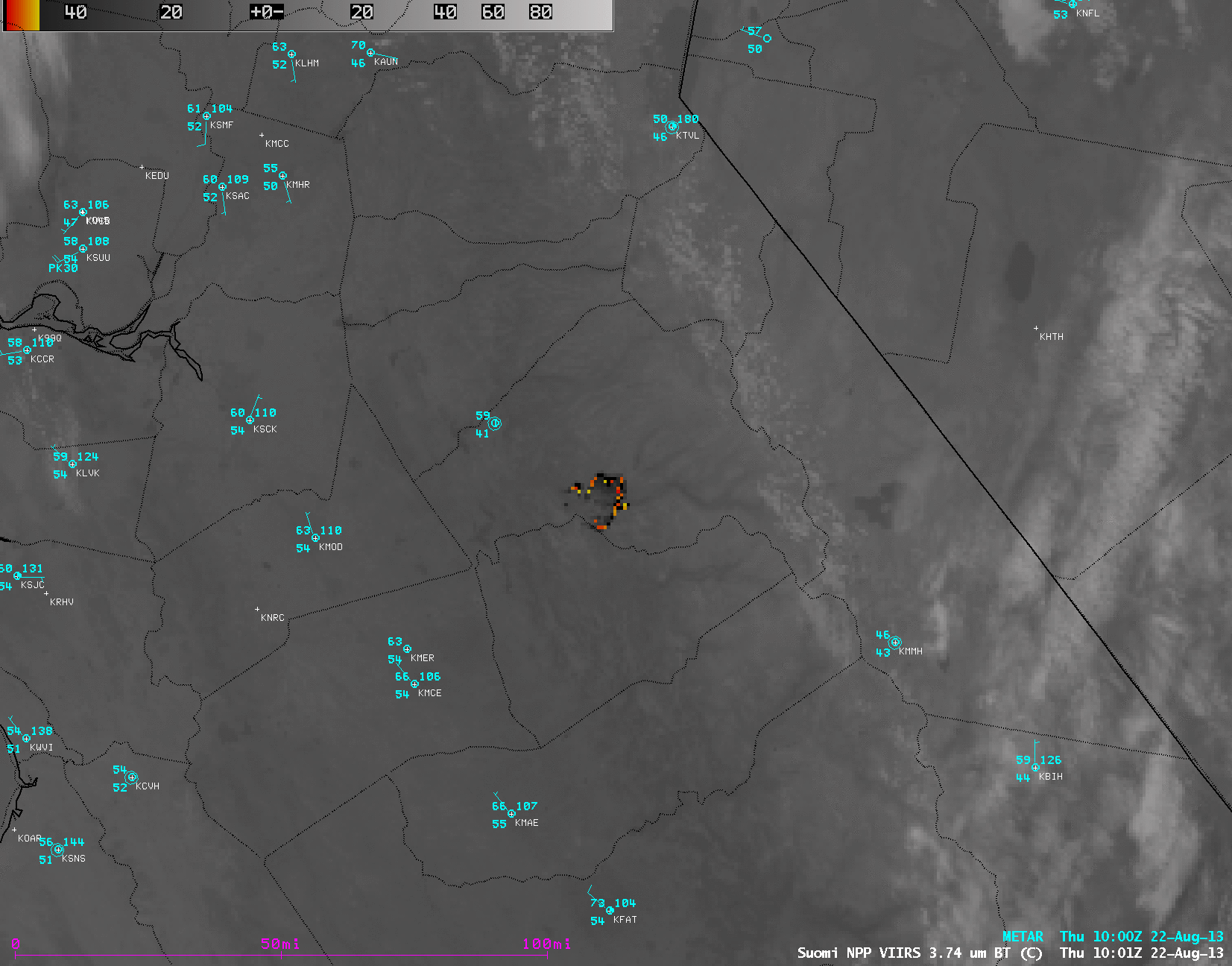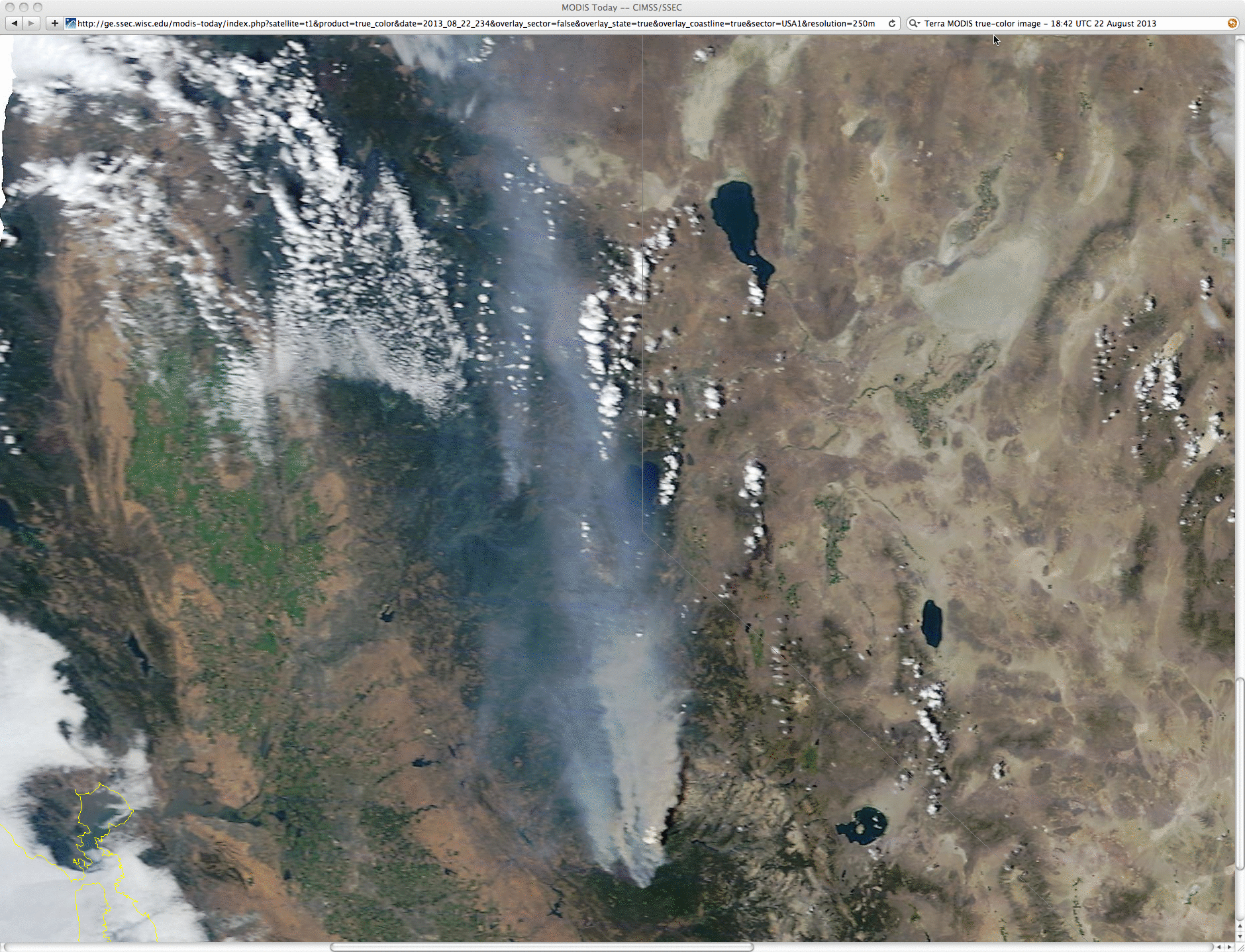…Note: scroll down to the bottom of this post for 22 August and 23 August updates…
On August 19, 2013, the Rim Fire complex in Groveland, CA spawned a pyrocumulonimbus cloud as it burned through the Stanislaus National Forest. The GOES-14 satellite was also placed into Super Rapid Scan Operations for GOES-R (SRSO-R) for the day, providing imagery at 1-minute intervals. Taking a look at the GOES-14 visible imagery (above, left; click image to play animation), a white plume (our soon-to-be pyroCb) can be seen erupting from the fire complex in the center of the image at around 23 UTC. The fire complex becomes enveloped by convection from the east as the evening progresses, but the path of the initial “pyroburst” (see previous blog post) can be seen throughout. As this plume drifts to the northwest, it develops into a pyroCb, casting a shadow over some lower-level clouds. Taking a look at the GOES-14 shortwave IR imagery (above, right; click image to play animation), the pyroCb (lighter pixels) can be seen emanating from the fire complex (red pixels). The red pixels to the south and southeast at the beginning of the animation are not wildfires; rather, these pixels indicate extreme temperatures at ground level, which are not uncommon in the western US at midday during the summer.
The GOES-14 longwave IR imagery (above; click image to play animation), shows the evolution of the pyroCb’s cloud-top temperatures over time. At the time of its conception, at ~23 UTC, the cloud top temperatures average around -30 degrees Celsius (dark blue color enhancement). By the time the pyroCb is due west of Lake Tahoe (0:45 UTC on Aug 20), temperatures are as low as -50º C (yellow/orange color enhancement). As the pyroCb drifts further north, above the lower-level clouds, temperatures approach -60º C (red color enhancement).
===== 22 August Update =====
A night-time (10:01 UTC or 3:01 AM local time) comparison of AWIPS images of Suomi NPP VIIRS 3.74 µm shortwave IR and 0.7 µm Day/Night Band data (above) showed signatures of the Rim Fire which had been burning since 17 August near Yosemite National Park in California. On the shortwave IR image, numerous “hot spots” (black to yellow to red enhancement) revealed the location of larger, hotter fires that were burning along the periphery of the large burn scar. The Day/Night Band image showed (1) a bright white glow over the area of active fires, and (2) light gray signatures of the primary middle to upper altitude smoke plume that was moving northward, in addition to an area of lower altitude smoke that was moving westward toward lower elevations. Due to ample illumination from a 98% full waning gibbous Moon phase, the “visible image at night” capability of the Day/Night Band proved to be useful for identifying the location of the smoke plumes.
Later that day during the afternoon hours the Rim Fire exhibited very active growth, nearly doubling in size to over 105,000 acres (Wildfire Today | InciWeb). A comparison of 250-meter resolution MODIS true-color and false-color images from the SSEC MODIS Today site (below) showed the large and very dense smoke plume at 18:42 UTC (11:42 AM local time).
The GOES-14 satellite had been placed into Super Rapid Scan Operations for GOES-R (SRSO-R) mode, providing images at 1-minute intervals during the entire day. A sequence of these GOES-14 SRSO-R 0.63 µm visible channel images (below; click image to play animation) showed that the initial northward motion of the smoke plume began to transition to a more northeasterly motion after about 17 UTC. This was due to a shift in the winds aloft as a semi-stationary cut-off low just west of the coast of California began to move northward during the day.
The change in the winds aloft which allowed the smoke plume to begin drifting more toward the northeast prompted the National Weather Service forecast office at Reno, Nevada to amend their forecasts for some areas to include smoke and haze (complete AFD):
AREA FORECAST DISCUSSION
NATIONAL WEATHER SERVICE RENO NV
207 PM PDT THU AUG 22 2013
ONLY MINOR CHANGES MADE TO ONGOING FORECAST WITH THE GREATEST CHANGE TO ADD SMOKE AND HAZE DUE TO MULTIPLE ONGOING WILDFIRES, THE GREATEST CONTRIBUTOR BEING THE RIM FIRE JUST WEST OF YOSEMITE. THE UPPER LEVEL LOW WHICH HAS BROUGHT US PLENTY OF THUNDERSTORMS THE PAST FEW DAYS IS BEGINNING TO LIFT NORTH WITH A DRIER SOUTHWEST FLOW RESULTING ACROSS NORTHEAST CALIFORNIA AND NORTHWEST NEVADA.
Surface visibilities at locations such as South Lake Tahoe were reduced as low as 1.25 miles once the smoke plume began to move over that area.
===== 23 August Update =====
Suomi NPP VIIRS 3.74 µm shortwave IR images on 3 consecutive nights (21, 22, and 23 August) showed the rapid increase in size of the Rim Fire (above).
Another example of smoke from the Rim Fire being detected during the night-time hours can be seen at 09:43 UTC or 2:43 AM local time on 23 August (below). The VIIRS 0.7 µm Day/Night Band image revealed a number of discrete plumes of smoke streaming northward, then northeastward toward the Lake Tahoe area. At South Lake Tahoe the surface visibility at the time of the image was 2 miles, but it decreased to 1/2 mile four hours later.




